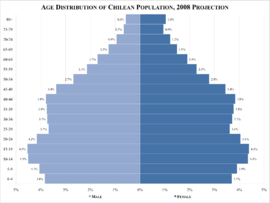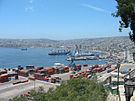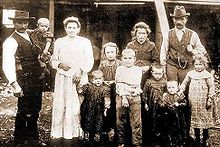- Demographics of Chile
-
Demographics of Chile 
Population pyramid of Chile, 2008Population: 17,094,270 (2010 est.)[1] Growth rate: 0.856% (2010 est.)[2] Birth rate: 14.46 births/1,000 population (2010 est.) Death rate: 5.9 deaths/1,000 population (July 2010 est.) Life expectancy: 77.53 years –male: 74.26 years –female: 80.96 years (2010 est.) Fertility rate: 1.9 children born/woman (2010 est.) Infant mortality rate: 7.52 deaths/1,000 live births Age structure: 0-14 years: 23.2% (male 1,966,017/female 1,877,963) 15-64 years: 67.8% (male 5,625,963/female 5,628,146) 65-over: 9.1% (male 627,746/female 875,872) (2010 est.) Sex ratio: Total: 0.98 male(s)/female (2010 est.) At birth: 1.05 male(s)/female Under 15: 1.05 male(s)/female 15-64 years: 1 male(s)/female 65-over: 0.72 male(s)/female Nationality: Nationality: Chilean Major ethnic: White and White-Mestizo 95.4% Minor ethnic: Mapuche 4%, other indigenous groups 0.6% (2002 census) Language: Official: Spanish This article is about the demographic features of Chile, including population density, ethnicity, economic status and other aspects of the population.
Chile's 2002 census reported a population of 15,116,435 people. Its rate of population growth has been decreasing since 1990, because of a declining birth rate.[3] By 2050 the population is expected to reach approximately 20.2 million people.[4] About 85% of the country's population lives in urban areas, with 40% living in Greater Santiago. The largest agglomerations according to the 2002 census are Greater Santiago with 5.6 million people, Greater Concepción with 861,000 and Greater Valparaíso with 824,000.[5]
Contents
Ethnic structure
Chile is a multiethnic society, which means that it is home to people of many different ethnic backgrounds. As a result, the people there usually treat their nationality as a citizenship, but not an ethnicity.
One study conducted by Francisco Lizcano from UNAM suggested that people of European origin made up 52.7% of the population and that Mestizos made up 44% of the population.[6] Other studies have found a white majority that would exceed 60% of the Chilean population.[7][8]
European and, to a lesser extent, Middle Eastern emigration to Chile, chiefly during the second half of the 19th century and throughout the twentieth, was the most important in Latin America after emigrations to the Atlantic Coast of the Southern Cone (that is, to Argentina and southern Brazil).[9][10][11]
The Afro-Chilean population has always been tiny, reaching a high of 2,500 people during the colonial period; their current percentage of the population is less than 0.1%.[12] According to the 2002 Census, 4.6% of the Chilean population considered themselves indigenous.[13]
Indigenous communities
The 1907 census reported 101,118 Indians, or 3.1% of the total country population. Only those that practiced their native culture or spoke their native language were considered, irrespective of their "racial purity."[14]
According to the 2002 census, only indigenous people that still practiced a native culture or spoke a native language were surveyed, and 4.6% of the population (692,192 people) fit that description. Of that 4.6%, 87.3% declared themselves Mapuche.[15] Most of the indigenous population show varying degrees of mixed ancestry.[13]
Chile is one of the twenty-two countries to have signed and ratified the only binding international law concerning indigenous peoples, Indigenous and Tribal Peoples Convention, 1989.[16] It was adopted in 1989 as the International Labour Organization (ILO) Convention 169. Chile ratified the convention in 2008. In November 2009, a court decision in Chile, considered to be a landmark ruling in indigenous rights concerns, made use of the ILO convention 169. The Supreme Court decision on Aymara water rights upholds rulings by both the Pozo Almonte tribunal and the Iquique Court of Appeals, and marks the first judicial application of ILO Convention 169 in Chile.[17]
Those belonging to recognised indigenous communities (2002) Alacaluf 2,622 0.02% Mapuche 604,349 4.00% Atacameño 21,015 0.14% Quechua 6,175 0.04% Aymara 48,501 0.32% Rapanui 4,647 0.03% Colla 3,198 0.02% Yámana 1,685 0.01% European
The largest contingent of people to have arrived in Chile came from Spain and the Basque country, a region divided between northern Spain and southern France. Estimates of the number Chileans who can trace at least some descent from Basques range from 10% (1,600,000) to as high as 27% (4,500,000).[18][19] [20] [21] [22][23][24][25]
Chile's various waves of non-Spanish immigrants include Italians, Irish, French, Greeks, Germans, English, Scots, and Croats.
In 1848 an important and substantial German immigration took place, laying the foundation for the German-Chilean community.[26][27] Sponsored by the Chilean government for the colonization of the southern region, the Germans (including German-speaking Swiss, Silesians, Alsatians and Austrians), strongly influenced the cultural and racial composition of the southern provinces of Chile. It is difficult to count the number of descendants of Germans in Chile, given the great amount of time. Because many areas of southern Chile were sparsely populated, the traces of German immigration that are quite noticeable. But the Consulate of Chile in Germany estimated that between 500,000 to 600,000 Chileans of German descent.[28]
Other historically significant immigrant groups included Croats, whose descendants today are estimated at 380,000 persons, or 2.4% of the Chilean population[29][30] Some authors claim that close to 4.6% of the Chilean population must have some Croatian ancestry.[31] Over 700,000 Chileans (4.5% of the Chilean population) may have British (English, Scottish or Welsh) forebears.[32] Chileans of Greek descent are estimated to number between 90,000 and 120,000;[33] most live in or near either Santiago or Antofagasta, and Chile is one of the five countries in the world most populated with descendants of Greeks.[34] The descendants of Swiss immigrants add 90,000,[35] and it is estimated that about 5% of the Chilean population has some French ancestry.[36] Between 600.000 to 800.000 Chileans descend from Italian immigrants. Other groups of Europeans have followed but are found in smaller numbers, as the descendants of Austrians[37] and Dutchmen it is currently estimated at about 50,000.[38][39] Altogether, these immigrants with their descendants, they have transformed the country culturally, economically and politically.
Other ethnic groups
Main article: Arab ChileansIt is estimated that near the 5% of the Chilean population is of Asian origin immigrants descendant, chiefly of the Middle East (i.e. Palestinians, Syrians, Lebanese and Middle East Armenians), are around 800,000.[40][41] Note that Israelis, both Jewish and non-Jewish citizens of the nation of Israel may be included. Chile is home to a large population of immigrants, mostly Christian, from the Levant.[42] Roughly 500,000 Palestinian descendants are believed to reside in Chile.[43][44][45][46][47]
In recent years, Chile had a growing East Asian population: considerably from China (see Chinese Chilean), a more recent wave from Japan (see Japanese Chilean) and South Korea (see Koreans in Chile). The earliest wave of East Asian immigration took place in the late 19th and early 20th centuries, mainly Chinese and Japanese contract laborers. There are less than 100,000 East Asians in Chile, about one percent of the population.[citation needed]
Chile administers Easter Island a territory 4,100 km west of the mainland. The Rapa Nui people are native to the island and are Polynesian in origin. About 3,500 live on the island, but 10,000 more came to the mainland in the 20th century. The Rapa Nui people fought to obtain self-autonomous government in Easter Island with success.[citation needed]
There is a sizable population of Roma people in Chile. They are widely and easily recognized, and continue to hold on to their traditions and language and many continue to live semi-nomadic lifestyles traveling from city to city and living in small tented communities.
Recent immigration
Since the reinstatement of democratic government in Chile, the former tendency for emigrants from the country to outnumber immigrants to it has reversed. Chile now is one of the two countries in Latin American with a positive migration rate.[48]
Today, the principal immigrant groups correspond to the countries bordering Chile. Argentines constitute the largest group, followed by Peruvians. One of the principal factors contributing to such immigration has been the growth of the Chilean economy during the past few decades. Immigration from other Latin American countries has also occurred.
According to the 2002 report of the International Organization for Migration, more than 10,000 people from the United States have emigrated to Chile. Most of these arrived in Chile initially to work for multinational corporations, most possess professional degrees, and most are well situated economically.
Religion
In the most recent census (2002), 70 percent of the population over age 14 identified as Roman Catholic and 15.1 percent as evangelical. In the census, the term "evangelical" referred to all non-Catholic Christian churches with the exception of the Orthodox Church (Greek, Persian, Serbian, Ukrainian, and Armenian), the Church of Jesus Christ of Latter-day Saints (Mormons), Seventh-day Adventists, and Jehovah's Witnesses. Approximately 90 percent of evangelicals are Pentecostal. Wesleyan, Lutheran, Reformed Evangelical, Presbyterian, Anglican, Episcopalian, Baptist and Methodist churches are also present.[49] Irreligious people, atheists and agnostics, account for around 8% of the population.
The Constitution provides for freedom of religion, and other laws and policies contribute to the generally free practice of religion. The law at all levels protects this right in full against abuse, either by governmental or private actors.[49]
Church and state are officially separate in Chile. The 1999 law on religion prohibits religious discrimination. However, the Catholic Church enjoys a privileged status and occasionally receives preferential treatment. Government officials attend Catholic events as well as major Protestant and Jewish ceremonies.[49]
The Government-observed religious holidays include Christmas, Good Friday, the Feast of the Virgin of Carmen, the Feast of Saints Peter and Paul, the Feast of the Assumption, All Saints Day, and the Feast of the Immaculate Conception as national holidays.[49] The government has recently declared October 31, Reformation Day, a public national holiday, in honor of the Protestant churches of the country.[50][51]
Languages
The Spanish spoken in Chile is distinctively accented and quite unlike that of neighbouring South American countries because final syllables and "s" sounds are dropped, and some consonants have a soft pronunciation. Accent varies only very slightly from north to south; more noticeable are the small differences in accent based on social class or whether one lives in the city or the country. That the Chilean population was largely formed in a small section at the center of the country and then migrated in modest numbers to the north and south helps explain this relative lack of differentiation, which was maintained by the national reach of radio, and now television, which also helps to diffuse and homogenize colloquial expressions.[52]
There are several indigenous languages spoken in Chile: Mapudungun, Quechua, Aymara and Rapa Nui. After the Spanish invasion, Spanish took over as the lingua franca and the indigenous languages have become minority languages, with some now extinct or close to extinction.[53]
German is spoken to a great extent in southern Chile,[54] either in small country side pockets or as a second language among the communities of larger cities.
Through initiatives such as the English Opens Doors program, the government made English mandatory for students in fifth-grade and above in public schools. Most private schools in Chile start teaching English from kindergarten.[55] Common English words have been absorbed and appropriated into everyday Spanish speech.[56]
In 2010, all students from 3rd grade in "Enseñanza Media" (secondary school) will be tested on listening and reading comprehension. The evaluation is compulsory and the instrument is TOIEC Bridge, developed by Educational Testing Service.
Largest cities
This list includes conurbations and cities with over 150,000 inhabitants. Information is from the 2002 census. (Note: The population given is limited to the city area and is not the population in the whole commune.)[57]
Largest cities of Chile
2002 Census[58]Rank City Name Province Pop. 
Santiago
1 Santiago Santiago Province 5,428,590 
Greater Valparaiso
2 Greater Concepción Concepción Province 848,023 3 Greater Valparaiso Valparaíso Province 824,006 4 Greater La Serena Elqui Province 296,253 5 Antofagasta Antofagasta Province 285,255 6 Greater Temuco Cautín Province 260,878 7 Rancagua conurbation Cachapoal Province 236,363 8 Greater Iquique Iquique Province 216,419 9 Talca Talca Province 191,154 10 Arica Arica Province 175,441 Graphs and maps
-
Chile. Population density by commune, based on census 2009
References
- ^ [1]
- ^ Chile entry at The World Factbook
- ^ "Anuario Estadísticas Vitales 2003". Instituto National de Estadísticas. http://www.ine.cl/canales/chile_estadistico/demografia_y_vitales/estadisticas_vitales/pdf/anuarios/vitales2003.zip.
- ^ "Chile: Proyecciones y Estimaciones de Población. Total País 1950-2050". Instituto National de Estadísticas. http://www.ine.cl/canales/chile_estadistico/demografia_y_vitales/proyecciones/Informes/Microsoft%20Word%20-%20InforP_T.pdf.
- ^ "List of Chilean cities". Observatorio Urbano, Ministerio de Vivienda y Urbanismo de Chile. http://www.observatoriourbano.cl/indurb/pre_ciudades.asp?id_user=0&idComCiu=0.
- ^ Fernández, Francisco Lizcano (2007). Composición Étnica de las Tres Áreas Culturales del Continente Americano al Comienzo del Siglo XXI. ISBN 9789707570528. http://books.google.com/?id=LcabJ98-t1wC&pg=PA93&lpg=PA93&dq=chile+60%25+blancos+Esteva-Fabregat.
- ^ "Genetic epidemiology of single gene defects in Chile". Ukpmc.ac.uk. http://ukpmc.ac.uk/articlerender.cgi?artid=1352132. Retrieved 2010-05-16.[dead link]
- ^ Esteva-Fabregat (1988), Book: El mestizaje en lberoamérica "a white majority that exceeds 60% of the Chilean population".
- ^ Juan Bialet Massé en su informe sobre "El estado de las clases obreras en el interior del país"
- ^ SOCIAL IDENTITY Marta Fierro Social Psychologist.
- ^ Etnicidad y ciudadanía en América Latina.
- ^ "Elementos de Salud Pública, section 5.2.6". University of Chile. http://mazinger.sisib.uchile.cl/repositorio/lb/ciencias_quimicas_y_farmaceuticas/medinae/.
- ^ a b "El gradiente sociogenético chileno y sus implicaciones ético-sociales". Medwave.cl. 2000-06-15. http://www.medwave.cl/ciencia/11.act. Retrieved 2010-05-16.
- ^ "1907 census". Memoriachilena.cl. http://www.memoriachilena.cl//temas/documento_detalle.asp?id=MC0007943. Retrieved 2010-05-16.
- ^ "Censo 2002 – Síntesis de Resultados". Instituto Nacional de Estadísticas. http://www.ine.cl/cd2002/sintesiscensal.pdf.
- ^ "ILOLEX: submits English query". Ilo.org. 2004-01-09. http://www.ilo.org/ilolex/cgi-lex/ratifce.pl?C169. Retrieved 2010-05-16.
- ^ "Chile's Supreme Court Upholds Indigenous Water Use Rights". The Santiago Times. 2009-11-30. http://www.santiagotimes.cl/index.php?option=com_content&view=article&id=17739:chiles-supreme-court-upholds-indigenous-water-use-rights&catid=19:other&Itemid=142. Retrieved 2010-03-02.
- ^ Diariovasco.
- ^ entrevista al Presidente de la Cámara vasca.
- ^ vascos Ainara Madariaga: Autora del estudio "Imaginarios vascos desde Chile La construcción de imaginarios vascos en Chile durante el siglo XX".
- ^ Basques au Chili.
- ^ Contacto Interlingüístico e intercultural en el mundo hispano.instituto valenciano de lenguas y culturas. Universitat de València Cita: " Un 20% de la población chilena tiene su origen en el País Vasco".
- ^ (Spanish) La población chilena con ascendencia vasca bordea entre el 15% y el 20% del total, por lo que es uno de los países con mayor presencia de emigrantes venidos de Euskadi.
- ^ El 27% de los chilenos son descendientes de emigrantes vascos. DE LOS VASCOS, OÑATI Y LOS ELORZA Waldo Ayarza Elorza.
- ^ (Spanish) Presencia vasca en Chile.
- ^ (Spanish) Los colonos
- ^ (Spanish) Alemanes en Chile.
- ^ Chilean Consulate in Germany
- ^ (Spanish) Diaspora Croata.
- ^ Splitski osnovnoškolci rođeni u Čileu.
- ^ hrvatski.
- ^ "Historia de Chile, Británicos y Anglosajones en Chile durante el siglo XIX". http://www.biografiadechile.cl/detalle.php?IdContenido=1673&IdCategoria=91&IdArea=488&TituloPagina=Historia%20de%20Chile. Retrieved 2009-04-26.
- ^ (Spanish) Embajada de Grecia en Chile.
- ^ (Spanish) Griegos de Chile
- ^ 90,000 descendants of Swiss in Chile.
- ^ (Spanish) 5% de los chilenos tiene origen frances.
- ^ Hoofdstuk XVI Historisch tussenspel
- ^ Dutch immigration.
- ^ Holando-bóers al sur de Chile.
- ^ (Spanish) Arabes de Chile.
- ^ (Spanish) En Chile viven unas 700.000 personas de origen árabe y de ellas 500.000 son descendientes de emigrantes palestinos que llegaron a comienzos del siglo pasado y que constituyen la comunidad de ese origen más grande fuera del mundo árabe.
- ^ Arab.
- ^ Chile: Palestinian refugees arrive to warm welcome.
- ^ (Spanish) 500,000 descendientes de primera y segunda generación de palestinos en Chile.
- ^ (Spanish) Santiago de Chile es un modelo de convivencia palestino-judía.
- ^ Exiling Palestinians to Chile.
- ^ (Spanish) Chile tiene la comunidad palestina más grande fuera del mundo árabe, unos 500.000 descendientes.
- ^ United Nations Population Division
- ^ a b c d "Chile". International Religious Freedom Report. United States Department of State. 2008-09-19. http://www.state.gov/g/drl/rls/irf/2008/108518.htm.
- ^ "Hola, Luther". The Economist. 6 November 2008. http://www.economist.com/world/americas/displaystory.cfm?story_id=12564066&fsrc=rss. Retrieved 17 April 2010. (subscription required)
- ^ Andrea Henríquez (2008-10-31). "BBC Mundo | A fondo | 2007 | En nombre de la fe | Los evangélicos tienen su feriado". BBC News. http://news.bbc.co.uk/hi/spanish/specials/2007/en_nombre_de_la_fe/newsid_7701000/7701290.stm. Retrieved 2009-12-17.
- ^ "Development and Breakdown of Democracy, 1830-1973". Country Studies. Library of Congress. 1994-03-31. http://countrystudies.us/chile/85.htm.
- ^ "Languages of Chile". http://www.ethnologue.com/show_country.asp?name=CL.
- ^ Oliver Zoellner. "Oliver Zoellner | Generating Samples of Ethnic Minorities in Chile". Research-worldwide.de. http://www.research-worldwide.de/article-chile2005.html. Retrieved 2009-12-17.
- ^ "Repeat after me: Hello, my name is". Globalpost.com. http://www.globalpost.com/dispatch/chile/090908/lack-english-proficiency. Retrieved 2010-05-16.
- ^ "Anglicism in Chilean Spanish". Scielo.cl. 2004-05-04. http://www.scielo.cl/scielo.php?pid=S0718-04622005000200010&script=sci_arttext. Retrieved 2010-05-16.
- ^ Chile: Ciudades, Pueblos, Aldeas y Caseríos 2005, Instituto Nacional de Estadísticas – June 2005.
- ^ Chile: Ciudades, Pueblos, Aldeas y Caseríos 2005, Instituto Nacional de Estadísticas – June 2005.
Demographics of South America Sovereign states Dependencies and
other territories- Aruba
- Bonaire
- Curaçao
- Falkland Islands
- French Guiana
- South Georgia and the South Sandwich Islands
 Chile topics
Chile topicsHistory Timeline · First inhabitants · Captaincy General of Chile · Arauco War · Independence · Parliamentary Era (1891-1925) · Presidential Republic (1925–1973) · Presidency of Salvador Allende · 1973 coup · Pinochet regime · Transition to democracyLaw Constitution · Supreme Court · Civil Code · Law enforcement · Nationality law · Copyright law · Passport · Human rights · LGBT rightsPolitics Geography Regions · Provinces · Natural regions · Cities · Climate · Geology · Islands · Rivers · Extreme points · National ParksEconomy History · Peso · Central Bank · Stock Exchange · Companies · Agriculture · Communications · Transport · TourismMilitary Demographics Culture Other topics Healthcare · Education · Notable Chileans · International rankings · Holidays · Water supply and sanitation · Women · Beauty pageantsPortal · WikiProjectEthnic groups in Chile Indigenous peoples AraucanianOthersImmigration EuropeanOthersAfrican · Arab (Lebanese · Palestinian · Syrian) · Chinese · Indian · Japanese · Jewish · Korean · Taiwanese · Americans & CanadiansCategory:Ethnic groups in ChileCategories:- Chilean society
- Demographics of Chile
- Social history of Chile
-
Wikimedia Foundation. 2010.



